2. 青岛海洋科学与技术试点国家实验室 海洋生态与环境科学功能实验室,山东 青岛 266237
二甲基硫(Dimethylsulfide,DMS)是海水中含量最丰富的挥发性生源硫化物,它主要由其前体物质二甲基巯基丙酸内盐(Dimethylsulfoniopropionate,DMSP)分解产生。DMS在全球硫循环中发挥着重要作用,它可通过海-气交换进入大气,并对气候和环境变化产生重要的影响[1]。二甲亚砜(Dimethylsulfoxide,DMSO)是亚砜分子中分子量最小、也是最具有代表性的化合物,它在海水、淡水、雨水、河口和盐湖中广泛存在[2]。DMSO是海水中主要的溶解态生源硫化物,它可由浮游植物细胞释放产生,也可通过DMS的光化学氧化和微生物氧化生成[3-5],此外DMSO还可在某些厌氧细菌及微生物的作用下还原成DMS。Hatton[6]研究发现DMSO可在沉积物中产生,因此,沉积物可能成为深层海水中DMSO的来源,沉积物间隙水中DMSO的含量直接影响到沉积物与上覆水之间DMSO的交换。最新研究发现,某些合成DMSP的藻类和海洋细菌可以合成一种叫dimethylsulfoxonium propionate(DMSOP)的物质,DMSOP可以在海洋细菌的作用下降解生成DMSO[7],这也是DMSO的来源之一。尽管DMSO挥发性较弱,不能直接对全球的气候变化造成影响,但作为DMS潜在的源和汇,它可以通过与DMS的相互关系,在DMS的生物地球化学循环过程中发挥重要的作用,并对气候造成间接影响[8-9]。
目前,国外对于DMSO的分布、来源途径及影响因素的研究已取得了较好的进展[10-12],国内学者对DMSO的测定方法及其在中国近海DMSO的分布及影响因素也进行了一定的研究[2, 8, 13-14],但对于沉积物间隙水中DMSO的研究相对较少,对海洋DMSO的源汇过程缺乏系统的认识。此外,作为DMS潜在的源与汇,DMSO是海洋硫循环的重要一环,然而国内关于DMSO的研究工作远落后于对其它生源有机硫化物DMS、DMSP等的研究。本文选择生态环境受人类活动影响较大的东海为调查海域,通过秋、夏两个航次的调查取样,对海区内DMSO的水平和垂直分布以及季节差异等进行了考察,并探究了DMSO与Chl a、温度、盐度等环境因子之间的关系,重点探讨了不同粒径浮游植物对DMSOp的贡献,并且对沉积物间隙水中DMSOd的浓度进行了测定,探讨了DMSO的来源过程,丰富了我国在东部陆架海区生源硫循环的研究内容,有利于更好地了解海洋生源硫的生物地球化学循环及环境气候效应。
1 材料与方法 1.1 样品采集与保存于2013年10月10日~11月21日(秋季)、2014年5月25日~6月11日(夏初)分别搭乘“科学三号”和“科学一号”科考船对中国东海海域进行现场调查,调查站位如图 1所示。秋季航次共包括7个断面、30个站位,夏初航次共设7个断面、23个站位。另外,选取秋季航次DH1断面研究DMSO的垂直变化规律,在DH2-2、DH4-2、DH5-1、DH6-3和DH7-3五个站位分别采集沉积物间隙水样品,研究沉积物对于底层海水DMSO的贡献。此外,在秋季航次选取9个站位进行不同粒径浮游植物中DMSOp的分布分析,讨论不同粒径浮游植物对于Chl a和DMSOp的贡献。本次调查在近岸和远海均有采样站点,具有一定代表性,能够代表整个调查海域中Chl a和DMSOp的粒径分布情况。
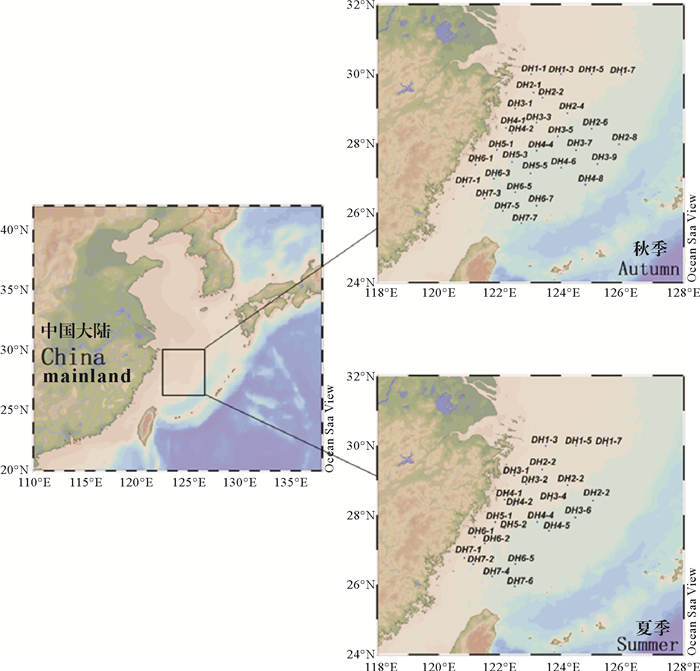
|
图 1 2013年秋季和2014年夏初东海海域调查站位图 Fig. 1 Locations of the sampling stations in the East China sea during autumn in 2013 and during early summer in 2014 |
海水样品使用Niskin Rosette采水器采集,采样深度、海水温度、盐度等可由直读式温盐深仪(CTD)直接读取。对于DMSOd样品,将采集到的海水通过直径为47 mm的Whatman GF/F玻璃纤维滤膜进行重力过滤,待滤过几毫升海水后,接取4 mL滤液转移至样品瓶中,向内加入20 μL 25%盐酸固定。对于DMSOt样品,直接取4 mL未经过滤的海水置于盛有20 μL 25%盐酸的样品瓶中,低温避光保存。
对于沉积物间隙水样品的采集,在Broadbent和Jones[15]所提出方法的基础上进行一定改进,具体操作流程如下:利用箱式采泥器将样品采集到甲板后,将特制的带孔PVC管(直径12 cm左右)缓慢插入到采集的沉积物中取得柱状样沉积物,然后将间隙水采集管穿过PVC管上的小孔插入沉积物中,并用一次性无菌针头与之相连接,最后将针头插入一次性真空采血管,沉积物间隙水即通过间隙水采样管进入采血管中,共采集间隙水样品2 mL。自表到底每隔1 cm取一层样品,共采集6层。
对于DMSOp粒径分级样品,将100 mL表层海水样品依次通过孔径为20、5、2和0.2 μm的滤膜进行重力过滤,将过滤后的滤膜迅速转移至盛有40 mL Milli-Q水的玻璃瓶中,并加入200 μL 25%盐酸进行固定,将其放置在0~4 ℃的暗处保存,回到陆上实验室后立即进行测定。Chl a粒径分级样品与之相似,将300 mL海水样品依次通过上述4种孔径滤膜进行抽滤(压力低于15 kPa),各滤膜对折置于锡纸内并低温保存。
1.2 分析方法DMSO的测定:定量移取1 mL海水样品至避光的样品瓶中,并用附有聚四氟乙烯膜的铝盖密封,用高纯氮气吹扫10 min后向内加入200 μL 20%的TiCl3溶液,并置于55 ℃水浴中恒温反应1 h,待其冷却至室温后,测定还原产生的DMS量,DMS的测定方法参照杨桂朋等的报道[16],按1∶1计量关系计算出DMSO的浓度。由于TiCl3溶液中含有HCl,可能会对最终的色谱峰产生影响[17],因此,在Nafion干燥器和捕集管之间放置一段装有K2CO3粉末的聚四氟乙烯管,以此消除HCl的干扰。该测定方法的相对标准偏差 < 5%,最低检出限为1 pmol DMSO。
Chl a的测定:取300 mL海水样品,使用直径为47 mm的Whatman GF/F玻璃纤维滤膜进行抽滤,为了防止细胞破裂,从而影响测定结果,压力不应大于15 kPa,用锡纸包裹滤膜,并冷冻保存。回到实验室后,将滤膜置于10 mL 90%(体积份数)的丙酮溶液中低温萃取,24 h后离心10 min(转速为4 000 r·min-1),取上清液用F-4500荧光仪(日本日立)采用荧光分光光度法[18]测定Chl a含量。
2 结果与讨论 2.1 表层海水中温度、盐度和Chl a的水平分布及季节变化秋季和夏初东海表层海水温度、盐度、Chl a、DMSOd和DMSOp的水平分布如图 2、图 3所示。秋季调查海域内温度和盐度的变化范围分别为20.54~25.25 ℃和29.07~34.45,平均值分别为23.30 ℃和33.62。夏初东海表层海水温度介于21.13~25.94 ℃之间,平均值为23.23 ℃;盐度介于29.73~34.27之间,平均值为32.34。由于受到长江冲淡水、东海沿岸流和台湾暖流的影响,两季节温度、盐度基本上呈现西北低、东南高,近岸低、远海高的分布趋势。夏初长江处于丰水期,长江冲淡水对调查海域的影响比秋季明显,更多低温低盐的淡水流入东海,而且秋季航次高温高盐的外海调查站位数量多于夏初季节,这导致了秋季航次的温度盐度反而略高于夏初季节。秋季和夏初东海表层海水中Chl a浓度变化范围分别为(0.10~3.30)和(0.03~10.03) μg·L-1,平均值分别为(0.69±0.59)和(1.15±2.21) μg·L-1。本研究Chl a浓度与Yang等[19](0.13~3.66 μg·L-1)和Zhang等[20](0.06~8.13 μg·L-1)对相同季节、相同海域的研究结果相近。两季节Chl a的分布规律不尽相同,但整体来说Chl a的浓度都是从营养盐丰富的近岸海域到外海逐渐减小。秋季Chl a最高浓度出现在杭州湾东边的DH1-1站位,这主要是由于东海沿岸流在秋季向南流,能够将长江冲淡水中含量较高的营养盐携带至该海域,进而有利于浮游植物的生长[21]。夏初Chl a的最高值出现在调查海域西南部的DH6-1站位,此处位于浙闽沿岸流与台湾暖流交汇的海区,而且毗邻浙江省的南麂岛[22],受人为活动影响较大,由于温度、盐度适宜,营养盐丰富,使此海域生产力水平较高。此外,位于浙江台州湾附近的DH4-1站位附近,Chl a的浓度也较高。
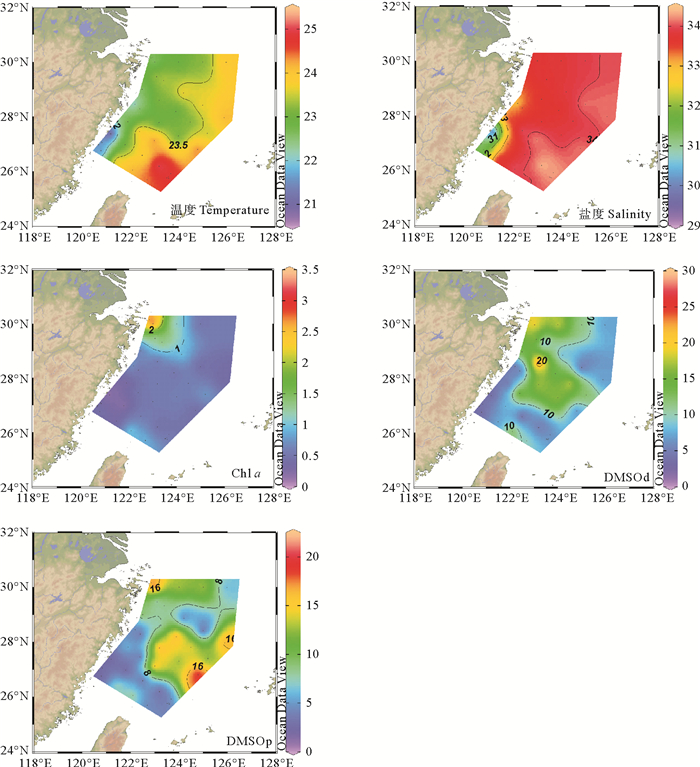
|
图 2 秋季东海表层海水中温度(℃)、盐度、Chl a(μg·L-1)、DMSOd和DMSOp(nmol·L-1)的水平分布 Fig. 2 Spatial distributions of temperature (℃), salinity, Chl a (μg·L-1), DMSOd and DMSOp (nmol·L-1) in the surface water of the East China Sea during autumn |
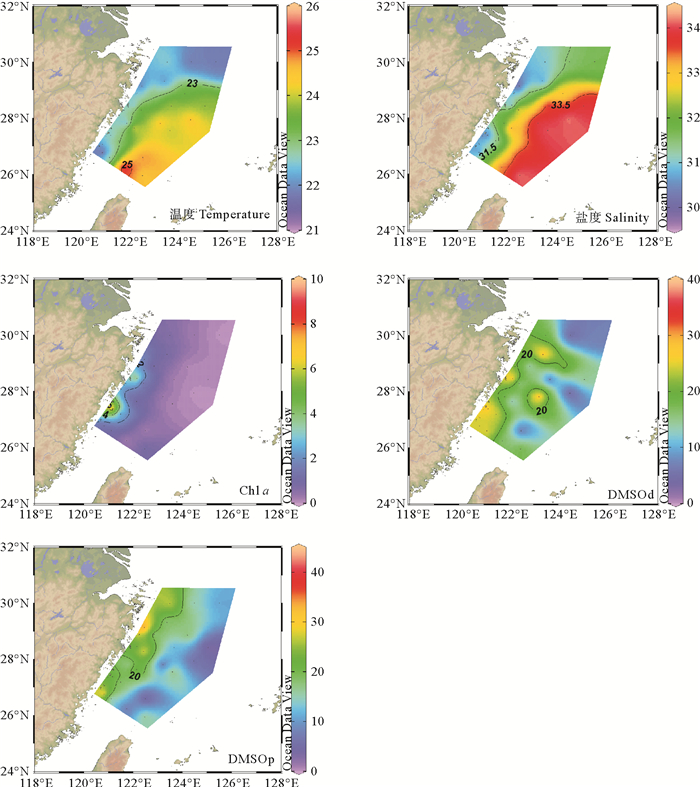
|
图 3 夏初东海表层海水中温度(℃)、盐度、Chl a(μg·L-1)、DMSOd和DMSOp(nmol·L-1)的水平分布 Fig. 3 Spatial distributions of temperature (℃), salinity, Chl a (μg·L-1), DMSOd and DMSOp (nmol·L-1) in the surface water of the East China Sea during early summer |
秋季东海海域表层海水中DMSOd和DMSOp的浓度范围分别为(2.23~28.64)和(1.18~20.49) nmol·L-1,平均值分别为(10.52±7.16)和(8.99±6.34) nmol·L-1。夏初该海域表层海水中DMSOd和DMSOp的浓度范围分别为(2.31~35.13)和(2.22~40.94) nmol·L-1,平均值分别为(17.51±9.90)和(16.96±10.73) nmol·L-1。秋季航次中,DMSOd和DMSOp的分布规律并不一致,DMSOd的高值区主要出现在调查海区西北部和台湾东北部海域,这两处Chl a浓度也较高,这表明浮游植物生产对该海域DMSOd的分布产生了重要影响。然而,DMSOd浓度最高值却出现在Chl a浓度(0.43 μg·L-1)并不太高的DH3-3站位处,该站位的DMS(6.15 nmol·L-1)和溶解有机碳(Dissolved organic carbon,DOC)(10.70 mg·L-1)浓度都相对较高,DMS的光化学氧化可能是出现DMSOd浓度最大值的原因。Hatton[23]发现在DOC浓度高于0.90 mg·L-1时,海水中高达99%的DMS会在UVA可见光下被氧化成DMSO,表层海水中DOC浓度越高,DMS的光化学反应速率常数也越大,从而导致通过DMS氧化生成的DMSOd浓度也越高。DMSOp的高值区主要出现在温度和盐度较高的东南部外海海域,虽然DMSOp主要由浮游植物产生,但不同浮游植物生产DMSOp的能力不同,高温高盐的外海海域可能更适合DMSOp高产种的生长,因此即使Chl a相对较低,DMSOp也在该处出现了最大值,Yang等[24]也发现DMSOp的高值区出现在外海海域。夏初DMSOd和DMSOp的分布规律与Chl a相似,浓度由近岸向外海逐渐降低,此外,相关性结果表明夏初季节DMSOd与Chl a(r=0.516,p < 0.05)之间存在一定相关性。近岸较高的初级生产力和浮游植物生物量使得DMSOd和DMSOp在此区域出现最大值。此外,近岸DMSOd高值区也可能与陆源输入有关,DMSO在工业和农业生产中被广泛作为防腐剂、润滑剂等使用[25],因此,河流输入可携带人类活动产生的DMSOd进入海水中,从而造成近岸海域较高浓度的DMSOd。
总体上看,DMSOd和DMSOp存在明显季节差异,夏初DMSO的浓度高于秋季,可能是由于夏初陆源和河流输入带来了更为丰富的营养盐,较高的生产力使浮游植物合成更多的DMSO。之前的研究也发现夏季DMSOd和DMSOp浓度高于秋季[11, 26]。此外,太阳辐射强度、光照周期、细菌活动和海水季节性环流等因素也可能对DMSO浓度的季节性变化产生重要影响。例如,夏初光照强度和光照周期与秋季相比都较高,因此DMS的光化学氧化作用在夏初更加显著;夏初较高的细菌活性也会使得更多的DMS通过细菌氧化过程转化为DMSO。
2.3 沉积物间隙水中DMSOd的释放为了探究沉积物间隙水对于海水中DMSOd的贡献,我们在秋季航次选取了5个站位,研究了间隙水中DMSOd的分布情况。表 1显示的是底层海水中DMSOd的浓度和所取6层沉积物间隙水中DMSOd的平均浓度。通过对比可发现,沉积物间隙水中DMSOd浓度比底层海水中高出约10倍,这可能与沉积物中的浮游生物碎屑有关。真光层中的浮游植物碎屑以及被浮游动物摄食后的粪粒等下沉至海底,DMSOp随之转移到沉积物中,DMSOp的分解释放贡献了间隙水中较高浓度的DMSOd。此外,同航次调查结果显示,沉积物间隙水中DMSP浓度明显大于底层海水中的浓度[27],而沉积物中较高浓度的DMSP可分解生成DMS,进而被细菌氧化成为DMSOd[6]。沉积物间隙水中DMSOd浓度高于底层海水中的浓度表明,沉积物间隙水是海水中DMSOd的一个重要来源,尤其是对底层海水中的DMSOd有重要贡献。
|
|
表 1 各站位沉积物间隙水与底层海水中DMSOd的浓度 Table 1 DMSOd concentrations in the sediment porewater and the bottom water collected from different stations |
秋季东海海域DH1断面温度、盐度、Chl a和DMSO的垂直分布如图 4所示。秋季调查海域温度、盐度混合比较充分,垂直分布均匀,无分层现象,呈现出近岸高、远海低的分布规律。Chl a总体也呈现近岸高、远海低的趋势,在垂直分布上,表层浓度高于深层,最大值出现在近岸DH1-1表层海水中,且在该站位附近出现明显的分层现象。从DMSOd的垂直分布图可以看出,DMSOd在深层海水中出现高值,可能与海底沉积物有关,前文间隙水中DMSOd的分布也表明,沉积物是深层海水中DMSOd的一个重要来源。DMSOp最大值出现在DH1-1站位底层海水中,这可能是由于DH1-1站位表层海水中浮游植物生物量较高,更多的浮游植物颗粒、碎屑下沉至深层海水中发生沉积,研究期间水体处于垂直混合状态,这可能导致底层沉积物的再悬浮,从而促进底层水体DMSOp的再生产。
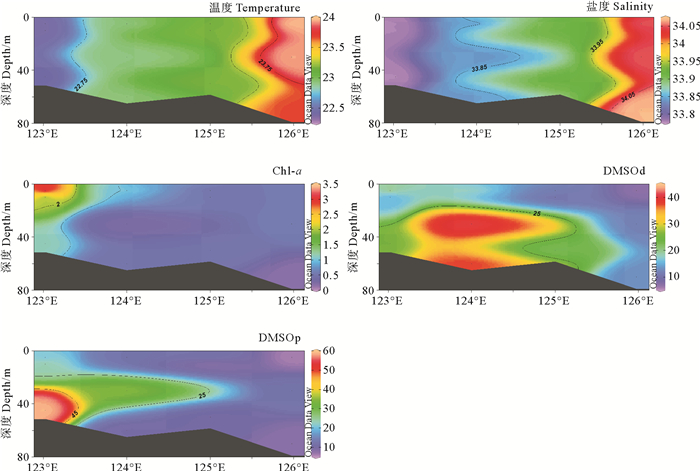
|
图 4 秋季东海海域温度(℃)、盐度、Chl a(μg·L-1)、DMSOd和DMSOp(nmol·L-1)的垂直分布 Fig. 4 Vertical distributions of temperature (℃), salinity, Chl a (μg·L-1), DMSOd and DMSOp (nmol·L-1) in the East China sea during autumn |
DMSOp/Chl a比值常被用来评估不同海区浮游植物生产DMSO的能力,该比值在一定程度上可以消除海区生物量的影响,比值的大小取决于该海域优势藻的种类。在秋季,调查海域表层海水中DMSOp/Chl a比值的变化范围为2.41~49.52 mmol·g-1,平均值为(17.23±15.14)mmol·g-1,夏初东海表层海水中DMSOp/Chl a比值介于2.33~181.40 mmol·g-1之间,平均值为(61.66±58.85)mmol g-1,这与2013年夏季相同海域调查结果一致(54.56 mmol·g-1)[28]。夏、秋两航次DMSOp/Chl a的高值区均出现在远海海域,低值区出现在近岸(见图 5),这可能是由浮游植物种类组成的差异性所致。从近岸到远海,随着温度的升高和盐度的增大,适于暖水、高盐环境生长的甲藻比例有所升高[29],而甲藻是DMSO高产种[26],因此远海海域DMSO生产能力较高。
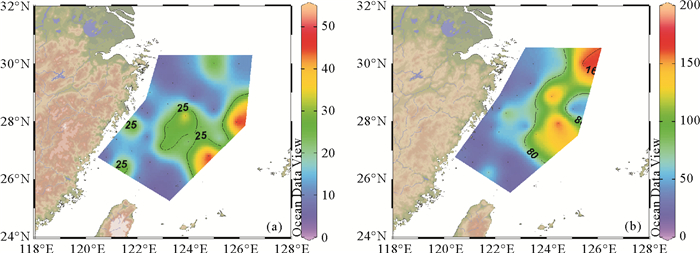
|
图 5 秋季(a)和夏初(b)东海海域表层海水中DMSOp/Chl a比值的水平分布 Fig. 5 Spatial distributions of DMSOp/Chl a ratios in the surface seawater of the East China sea during autumn (a) and early summer (b) |
为了进一步探讨不同粒径浮游植物对DMSOp和Chl a的贡献,在秋季东海航次中对二者的粒径分布进行了分析。本航次按照浮游植物粒径大小可大体将其分为超微型浮游植物(0.2~2 μm)、微型浮游植物(2~20 μm)和小型浮游植物(>20 μm)三类来研究调查海域中Chl a和DMSOp的粒径分布情况[30]。其中,微型浮游植物又可进一步分为2~5和5~20 μm两种粒径。总体来说,较大微型浮游植物(5~20 μm)是秋季东海表层海水中DMSOp和Chl a的主要贡献者(见图 6),其贡献率分别为50.9%和56.8%,这与Zhang等[20]的研究结果一致。然而,DMSOp和Chl a的粒径分布在近岸和远海海域有所差异。例如,在近岸的DH2-2和DH4-1站位,小型浮游植物(>20 μm)也贡献了较多的DMSOp和Chl a,尤其在受长江冲淡水影响较大的DH2-2站位,小型浮游植物(>20 μm)成为DMSOp和Chl a的主要贡献者;而在远离近岸的DH3-7和DH4-8站位,超微型浮游植物(0.2~2 μm)的贡献不可忽视。研究表明,浮游植物种群结构与营养盐浓度水平和比例结构密切相关[31-32]。黄邦钦等[33]在对东海、黄海海域的研究中发现,在营养盐水平较高的近岸海域超微型浮游植物(0.2~2 μm)对Chl a的贡献较小,而在低营养盐的黑潮区其对Chl a的贡献极为重要。此外,研究结果表明,尽管较大微型浮游植物(5~20 μm)贡献了大多数的DMSOp和Chl a,这一粒径范围内DMSOp/Chl a比值的平均值仅为18.94 mmol·g-1,这反映出秋季调查海域内占优势地位的藻种是DMSO低产种。Yang等[19]调查数据显示,硅藻在东海浮游植物群落中占绝对优势地位,而硅藻已被证明为DMSO的低产藻种,这与本文的研究结果一致。从图 6还可以看出,在DH7-7站位,尽管较大微型浮游植物(5~20 μm)贡献了大多数的Chl a,小型浮游植物(>20 μm)是该站位处DMSOp的主要贡献者。这可能是因为该海域受台湾暖流的影响,浮游植物种类组成与其它海域有所差异导致[34]。
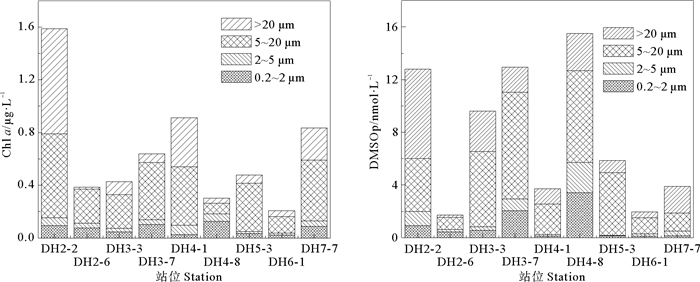
|
图 6 秋季东海表层海水中Chl a和DMSOp的粒径分布 Fig. 6 Size distributions of Chl a and DMSOp in the surface seawater of the East China Sea during autumn |
秋季和夏初航次东海海域表层海水DMSOd和DMSOp存在明显季节差异,夏初DMSO的浓度高于秋季。此外,由于受到生产力水平、浮游植物种群结构和其他环境因素的综合影响,DMSO在两个季节所呈现出的水平分布规律不一致,秋季DMSOp的高值区主要出现在外海海域,夏初DMSO的浓度从近岸到外海逐渐降低。沉积物间隙水中DMSOd的浓度明显高于底层海水,说明间隙水中DMSOd的释放是海水中DMSO的一个重要源。两航次DMSOp/Chl a比值的高值区均出现在调查海域的外海站位,表明外海海域浮游植物生产DMSO的能力要高于近岸。此外,粒径分析结果表明,秋季较大微型浮游植物(5~20 μm)是东海表层海水中DMSOp的主要贡献者。
| [1] |
Andreae M O. Ocean-atmosphere interactions in the global biogeochemical sulfur cycle[J]. Marine Chemistry, 1990, 30: 1-29. DOI:10.1016/0304-4203(90)90059-L
(  0) 0) |
| [2] |
杨桂朋, 杨洁. 海洋中二甲基亚砜的来源、分布及迁移转化[J]. 中国海洋大学学报(自然科学版), 2011, 41(4): 81-89. Yang G P, Yang J. The origin, fate and distribution of dimethylsulphoxide (DMSO) in seawater[J]. Periodical of Ocean University of China, 2011, 41(4): 81-89. (  0) 0) |
| [3] |
Brimblecombe P, Shooter D. Photo-oxidation of dimethylsulphide in aqueous solution[J]. Marine Chemistry, 1986, 19(4): 343-353. DOI:10.1016/0304-4203(86)90055-1
(  0) 0) |
| [4] |
Zeyer J, Eicher P, Wakeham S G, et al. Oxidation of dimethylsulfide (DMS) to dimethylsulfoxide (DMSO) by phototrophic purple bacteria[J]. Applied and Environmental Microbiology, 1987, 53(9): 2026-2032. DOI:10.1128/AEM.53.9.2026-2032.1987
(  0) 0) |
| [5] |
Simó R, Hatton A D, Malin G, et al. Particulate dimethylsulfoxide in seawater: production by microplankton[J]. Marine Ecology Progress, 1998, 167: 291-296. DOI:10.3354/meps167291
(  0) 0) |
| [6] |
Hatton A D. DMSP removal and DMSO production in sedimenting particulate matter in the northern North Sea[J]. Deep Sea Research Part Ⅱ: Topical Studies in Oceanography, 2002, 49(15): 3053-3065. DOI:10.1016/S0967-0645(02)00071-1
(  0) 0) |
| [7] |
Thume K, Gebser B, Chen L, et al. The metabolite dimethylsulfoxonium propionate extends the marine organosulfur cycle[J]. Nature, 2018, 563: 412-415. DOI:10.1038/s41586-018-0675-0
(  0) 0) |
| [8] |
王鑫, 张洪海, 杨桂朋. 东海和黄海冬季海水中二甲亚砜的分布及影响因素[J]. 环境科学研究, 2014, 27(10): 1119-1125. Wang X, Zhang H H, Yang G P. Distribution of dimethylsulfoxide and its influencing factors in the East China Sea and the Yellow Sea in Winter[J]. Research of Environmental Sciences, 2014, 27(10): 1119-1125. (  0) 0) |
| [9] |
高旭旭, 张洪海, 杨竣齐, 等. 夏季长江口及其邻近海域生源有机硫化物的分布与影响因素研究[J]. 环境科学学报, 2019, 39(3): 659-667. Gao X X, Zhang H H, Yang J Q, et al. Distributions of biogenic organic sulfur compounds and their influencing factors in the Yangtze (Changjiang) River Estuary and its adjacent area in summer[J]. Acta Scientiae Circumstantiae, 2019, 39(3): 659-667. (  0) 0) |
| [10] |
Simo R, Vila-Costa M. Ubiquity of algal dimethylsulfoxide in the surface ocean: Geographic and temporal distribution patterns[J]. Marine Chemistry, 2006, 100(1-2): 136-146. DOI:10.1016/j.marchem.2005.11.006
(  0) 0) |
| [11] |
del Valle D A, Kieber D J, Toole D A, et al. Dissolved DMSO production via biological and photochemical oxidation of dissolved DMS in the Ross Sea, Antarctica[J]. Deep Sea Research Part Ⅰ: Oceanographic Research Papers, 2009, 56(2): 166-177. DOI:10.1016/j.dsr.2008.09.005
(  0) 0) |
| [12] |
Hatton A D, Turner S M, Malin G, et al. Dimethylsulphoxide and other biogenic sulphur compounds in the Galapagos Plume[J]. Deep Sea Research Part Ⅱ: Topical Studies in Oceanography, 1998, 45(6): 1043-1053. DOI:10.1016/S0967-0645(98)00017-4
(  0) 0) |
| [13] |
王敏, 张洪海, 杨桂朋. 夏季黄渤海表层海水中二甲亚砜(DMSO)的浓度分布[J]. 环境科学, 2013, 34(1): 45-50. Wang M, Zhang H H, Yang G P. Distribution of dimethylsulfoxide (DMSO) in the surface water of the Yellow Sea and the Bohai Sea[J]. Environmental Science, 2013, 34(1): 45-50. (  0) 0) |
| [14] |
高楠, 张洪海, 杨桂朋. 秋季东海二甲基亚砜的分布与影响因素研究[J]. 海洋学报, 2014, 36(4): 110-117. Gao N, Zhang H H, Yang G P. Study on the distribution of dimethylsulfoxide and its influencing factors in the East China Sea during autumn[J]. Acta Oceanologica Sinica, 2014, 36(4): 110-117. (  0) 0) |
| [15] |
Broadbent A D, Jones G B. DMS and DMSP in mucus ropes, coral mucus, surface films and sediment pore waters from coral reefs in the Great Barrier Reef[J]. Marine and Freshwater Research, 2004, 55: 849-855. DOI:10.1071/MF04114
(  0) 0) |
| [16] |
杨桂朋, 康志强, 景伟文, 等. 海水中痕量DMS和DMSP分析方法的研究[J]. 海洋与湖沼, 2007, 38(4): 322-328. Yang G P, Kang Z Q, Jing WW, et al. An analytical method of determining trace quantities of dimethylsulfide and dimethylsulfoniopropionate in seawater[J]. Oceanologia Et Limnologia Sinica, 2007, 38(4): 322-328. (  0) 0) |
| [17] |
Deschaseaux E S, Kiene R P, Jones G B, et al. Dimethylsulphoxide(DMSO) in biological samples: a comparison of the TiCl3 and NaBH4 reduction methods using headspace analysis[J]. Marine Chemistry, 2014, 164: 9-15. DOI:10.1016/j.marchem.2014.05.004
(  0) 0) |
| [18] |
Parsons T, Maita Y, Lalli C M. A Manual of Chemical and Biological Methods for Seawater Analysis[M]. Oxford: Pergamon Press, 1984: 23-58.
(  0) 0) |
| [19] |
Yang G P, Zhang H H, Zhou L M, et al. Temporal and spatial variations of dimethylsulfide (DMS) and dimethylsulfoniopropionate (DMSP) in the East China Sea and the Yellow Sea[J]. Continental Shelf Research, 2011, 31(13): 1325-1335. DOI:10.1016/j.csr.2011.05.001
(  0) 0) |
| [20] |
Zhang S H, Yang G P, Zhang H H, et al. Spatial variation of biogenic sulfur in the south Yellow Sea and the East China Sea during summer and its contribution to atmospheric sulfate aerosol[J]. Science of the Total Environment, 2014, 488-489: 157-167. DOI:10.1016/j.scitotenv.2014.04.074l=|Engineering Failure Analysis||86||72|2018|||
(  0) 0) |
| [21] |
Beardsley R C, Limeburner R, Yu H, et al. Discharge of the Changjiang (Yangtze River) into the East China Sea[J]. Continental Shelf Research, 1985, 4(1-2): 57-76. DOI:10.1016/0278-4343(85)90022-6
(  0) 0) |
| [22] |
戴冬旭, 俞存根, 刘惠, 等. 南麂列岛东侧海域主要游泳动物生态位及种间联结性[J]. 应用生态学报, 2019, 30(12): 4249-4258. Dai D X, Yu C G, Liu H, et al. Niche and interspecific association of major nekton in the sea area to the east of the Nanji Islands[J]. Chinese Journal of Applied Ecology, 2019, 30(12): 4249-4258. (  0) 0) |
| [23] |
Hatton A D. Influence of photochemistry on the marine biogeochemical cycle of dimethylsulphide in the northern North Sea[J]. Deep Sea Research Part Ⅱ: Topical Studies in Oceanography, 2002, 49(15): 3039-3052. DOI:10.1016/S0967-0645(02)00070-X
(  0) 0) |
| [24] |
Yang J, Yang G P. Distribution of dissolved and particulate dimethylsulfoxide in the East China Sea in winter[J]. Marine Chemistry, 2011, 127(1-4): 199-209. DOI:10.1016/j.marchem.2011.09.006
(  0) 0) |
| [25] |
Simó R. Trace chromatographic analysis of dimethyl sulfoxide and related methylated sulfur compounds in natural waters[J]. Journal of Chromatography A, 1998, 807: 151-164. DOI:10.1016/S0021-9673(98)00086-7
(  0) 0) |
| [26] |
Hatton A D, Wilson S T. Particulate dimethylsulphoxide and dimethylsulphonio-propionate in phytoplankton cultures and Scottish coastal waters[J]. Aquatic Sciences, 2007, 69(3): 330-340. DOI:10.1007/s00027-007-0891-4
(  0) 0) |
| [27] |
刘龙. 长江口及东海陆架区生源硫的分布变化特征及影响因素[D]. 青岛: 中国海洋大学, 2015. Liu L. Distribution Characteristics and Influencing Factors of the Biogenic Sulfur in the Changjiang Estuary and the Shelf of the East China Sea[D]. Qingdao: Ocean University of China, 2015. (  0) 0) |
| [28] |
李江萍, 张洪海, 杨桂朋. 夏季中国东海生源有机硫化物的分布及其影响因素研究[J]. 环境科学, 2015, 36(1): 49-55. Li J P, Zhang H H, Yang G P. Distribution of biogenic organic dimethylated sulfur compounds and its influencing factors in the East China Sea in summer[J]. Environmental Science, 2015, 36(1): 49-55. (  0) 0) |
| [29] |
刘海娇, 傅文诚, 孙军. 2009-2011年东海陆架海域网采浮游植物群落的季节变化[J]. 海洋学报, 2015, 37(10): 106-122. Liu H J, Fu W C, Sun J. Seasonal variations of netz-phytoplankton community in East China Sea continental shelf from 2009-2011[J]. Haiyang Xuebao, 2015, 37(10): 106-122. (  0) 0) |
| [30] |
Andreae M O, Andreae T W, Meyerdierks D, et al. Marine sulfur cycling and the atmosphere aerosol over the springtime North Atlantic[J]. Chemosphere, 2003, 52(8): 1321-1343. DOI:10.1016/S0045-6535(03)00366-7
(  0) 0) |
| [31] |
Iverson R L, Nearhoof F L, Andreae M O. Production of dimethylsulfonium propionate and dimethylsulfide by phytoplankton in estuarine and coastal waters[J]. Limnology and Oceanography, 1989, 34(1): 53-67. DOI:10.4319/lo.1989.34.1.0053
(  0) 0) |
| [32] |
Wang B D, Wang X L, Zhao R. Nutrient conditions in the Yellow Sea and the East China Sea[J]. Estuarine, Coastal and Shelf Science, 2003, 58: 127-136.
(  0) 0) |
| [33] |
黄邦钦, 刘媛, 陈纪新, 等. 东海、黄海浮游植物生物量的粒级结构及时空分布[J]. 海洋学报, 2006, 28(2): 156-164. Huang B Q, Liu Y, Chen J X, et al. Temporal and spatial distribution of size fractionized phytoplankton biomass in East China Sea and Huanghai Sea[J]. Acta Oceanologica Sinica, 2006, 28(2): 156-164. (  0) 0) |
| [34] |
岑竞仪, 欧林坚, 李思, 等. 2014年春季黑潮与邻近海域甲藻组成及其对水团的指示作用[J]. 海洋与湖沼, 2017(5): 132-139. Cen J Y, Ou L J, Li S, et al. The species composition of dinoflagellate and its role ofindication to Kuroshio and adjacent waters in spring 2014[J]. Oceanologia et Limnologia Sinica, 2017(5): 132-139. (  0) 0) |
2. Laboratory for Marine Ecology and Environmental Science, Pilot National Laboratory for Marine Science and Technology(Qingdao), Qingdao 266237, China
 2021, Vol. 51
2021, Vol. 51


